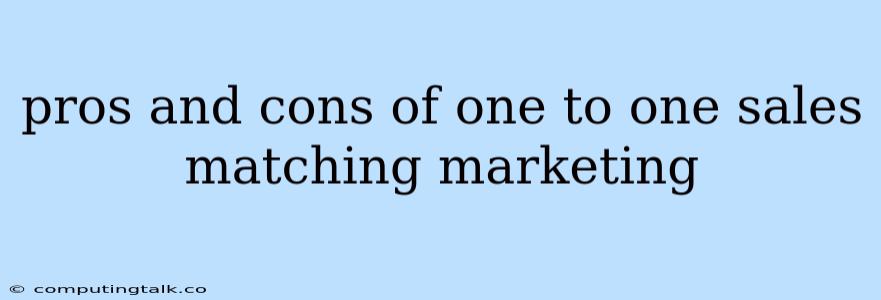The Power of Personalization: Pros and Cons of One-to-One Sales Matching Marketing
In today's highly competitive marketplace, businesses are constantly searching for innovative ways to connect with their target audience and drive conversions. One-to-one sales matching marketing, a strategy that focuses on creating personalized connections between individual sales representatives and potential customers, has emerged as a promising approach. This method leverages data analytics and sophisticated algorithms to identify ideal matches based on factors like demographics, interests, and purchase history, resulting in targeted outreach and customized interactions. While one-to-one sales matching marketing offers significant potential, it's crucial to understand both its advantages and disadvantages to determine if it's the right fit for your business.
Pros of One-to-One Sales Matching Marketing
- Enhanced Customer Engagement: One-to-one sales matching marketing fosters a more personalized and engaging experience for potential customers. By tailoring interactions to individual preferences and needs, businesses can build stronger relationships and increase the likelihood of conversion.
- Increased Conversion Rates: By connecting prospects with sales representatives who are best equipped to understand their specific needs and offer tailored solutions, this approach can lead to higher conversion rates. The personalized touch can significantly enhance the customer experience and create a sense of value, ultimately driving more sales.
- Improved Lead Quality: One-to-one sales matching marketing helps to identify and nurture higher-quality leads by focusing on prospects who are most likely to convert. This targeted approach minimizes wasted effort on unqualified leads and allows sales teams to concentrate their resources on those with the highest potential.
- Data-Driven Optimization: By leveraging data and analytics, businesses can continuously refine their sales matching algorithms and optimize their targeting strategies. This iterative process ensures that the system is constantly learning and adapting to changing market dynamics.
- Reduced Costs: One-to-one sales matching marketing can potentially reduce overall marketing costs by minimizing wasted efforts on unqualified leads. By focusing on high-quality leads and personalized outreach, businesses can optimize their spending and achieve a higher return on investment.
Cons of One-to-One Sales Matching Marketing
- Implementation Complexity: Setting up and maintaining a robust one-to-one sales matching system requires significant resources, including data infrastructure, analytics capabilities, and specialized software. The complexity of implementation can be a barrier for smaller businesses with limited resources.
- Privacy Concerns: One-to-one sales matching relies heavily on data collection and analysis, which raises concerns about data privacy and security. Businesses must adhere to relevant privacy regulations and ensure the responsible handling of sensitive customer data.
- Potential for Bias: Like any data-driven system, one-to-one sales matching algorithms can be susceptible to bias. If not carefully designed and monitored, these algorithms could inadvertently discriminate against certain customer segments, leading to ethical concerns.
- Over-personalization: While personalization is generally beneficial, excessive personalization can feel intrusive and potentially alienate customers. Finding the right balance between personalized interactions and respecting customer privacy is essential.
- Scalability Challenges: Scaling a one-to-one sales matching system to accommodate growing customer bases can be challenging. As the number of customers increases, the complexity of managing and optimizing the system can rise significantly.
Tips for Successful One-to-One Sales Matching Marketing
- Focus on High-Quality Data: The success of one-to-one sales matching hinges on the quality and accuracy of the data used to create matches. Invest in data collection and maintenance practices to ensure that your information is reliable and up-to-date.
- Develop a Robust Matching Algorithm: The algorithm that drives your sales matching system must be sophisticated enough to identify genuine connections based on relevant criteria. Consider factors like demographics, interests, purchase history, and behavioral data.
- Prioritize Customer Experience: The primary goal of one-to-one sales matching is to enhance customer experience. Ensure that interactions are personalized, relevant, and valuable. Avoid excessive personalization that can feel intrusive or overwhelming.
- Regularly Review and Optimize: Continuously monitor the performance of your sales matching system and make necessary adjustments based on data insights. Refine your algorithm, targeting strategies, and messaging to optimize results.
- Maintain Transparency: Be transparent with customers about how their data is being used for sales matching purposes. Adhere to all relevant privacy regulations and ensure that customer data is handled responsibly.
Conclusion
One-to-One sales matching marketing presents a compelling opportunity to create personalized and engaging customer experiences. By leveraging data and technology, businesses can connect with potential customers in a highly targeted and efficient manner. However, it's important to acknowledge the challenges associated with implementation, privacy concerns, and scalability. Careful planning, responsible data handling, and a focus on customer experience are essential for maximizing the benefits of this approach. By carefully considering the pros and cons and implementing best practices, businesses can harness the power of one-to-one sales matching marketing to build strong customer relationships and achieve sustainable growth.
